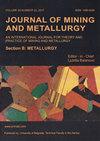注射孕育剂生产灰铸铁的试验评价
IF 1
4区 材料科学
Q3 METALLURGY & METALLURGICAL ENGINEERING
Journal of Mining and Metallurgy Section B-Metallurgy
Pub Date : 2021-01-01
DOI:10.2298/jmmb200414035r
引用次数: 0
摘要
通过向铁液中注入带输送气体的孕育剂,在实验室规模上对灰铸铁的产量进行了初步评估。对注入铁液的孕育剂颗粒之间的流体力学行为进行了数值模拟。实验结果表明,细颗粒(211 ~ 297 μ m)和中等颗粒(421 ~ 590 μ m)与铁液的最佳相互作用发生在7 cm,停留时间分别为0.38 s和0.4 s。细颗粒和中等颗粒的熔化时间分别为0.0008和0.003 s。注射后,孕育剂的FeSi迅速熔化,释放出孕育剂中的元素,这些元素与铁水相互作用,形成氧化物和硫化物,在凝固过程中形成成核点。注射技术允许获得a型石墨分布为细和中等粒度。在灰铸铁生产中,虽然石墨剂元素和锰含量较低,但随着孕育剂粒径的减小,共晶细胞数量增加。本文章由计算机程序翻译,如有差异,请以英文原文为准。
Experimental assessment of the gray cast iron production by inoculant injection
An initial assessment of the gray cast irons production by injecting an inoculant with a conveying gas into a molten iron bath was evaluated at a laboratory scale. A numerical simulation was carried out to determine the hydrodynamic behavior between the inoculant particles injected into the molten iron. It was determined that an optimal interaction between the particles with the molten iron occurred at a lance depth of 7 cm and for the particle sizes fine (211 to 297 ?m) and medium (421 to 590 ?m), and the residence time was of 0.38 and 0.4 s, respectively. The melting time was calculated at 0.0008 and 0.003 s for the particle sizes fine and medium, respectively. After the injection, the FeSi of the inoculant melted quickly, releasing the elements of the inoculant which interacted with the molten iron and formed oxides and sulfides creating nucleating sites during solidification. The injection technique allowed obtaining a type-A graphite distribution for the fine and medium particle sizes. The number of eutectic cells increased when the inoculant particle size decreased despite of the low graphitisers elements and manganese contents used in the gray cast iron manufacturing.
求助全文
通过发布文献求助,成功后即可免费获取论文全文。
去求助
来源期刊
CiteScore
2.00
自引率
40.00%
发文量
19
审稿时长
2 months
期刊介绍:
University of Belgrade, Technical Faculty in Bor, has been publishing the journal called Journal of Mining and Metallurgy since 1965 and in 1997 it was divided in two independent journals dealing with mining and metallurgy separately. Since 2009 Journal of Mining and Metallurgy, Section B: Metallurgy has been accepted in Science Citation Index Expanded.
Journal of Mining and Metallurgy, Section B: Metallurgy presents an international medium for the publication of contributions on original research which reflect the new progresses in theory and practice of metallurgy. The Journal covers the latest research in all aspects of metallurgy including hydrometallurgy, pyrometallurgy, electrometallurgy, transport phenomena, process control, solidification, mechanical working, solid state reactions, materials processing, surface treatment and relationships among processing, structure, and properties of materials.

 求助内容:
求助内容: 应助结果提醒方式:
应助结果提醒方式:


